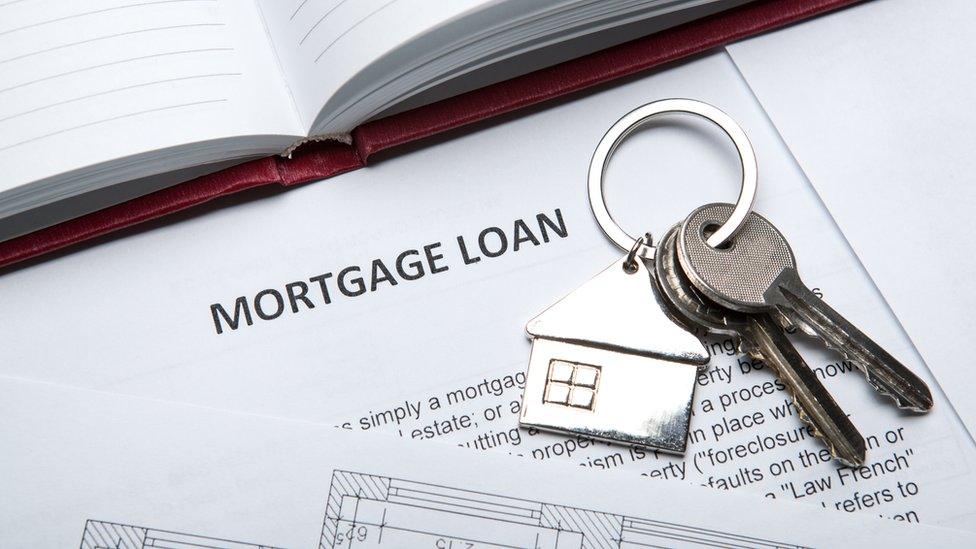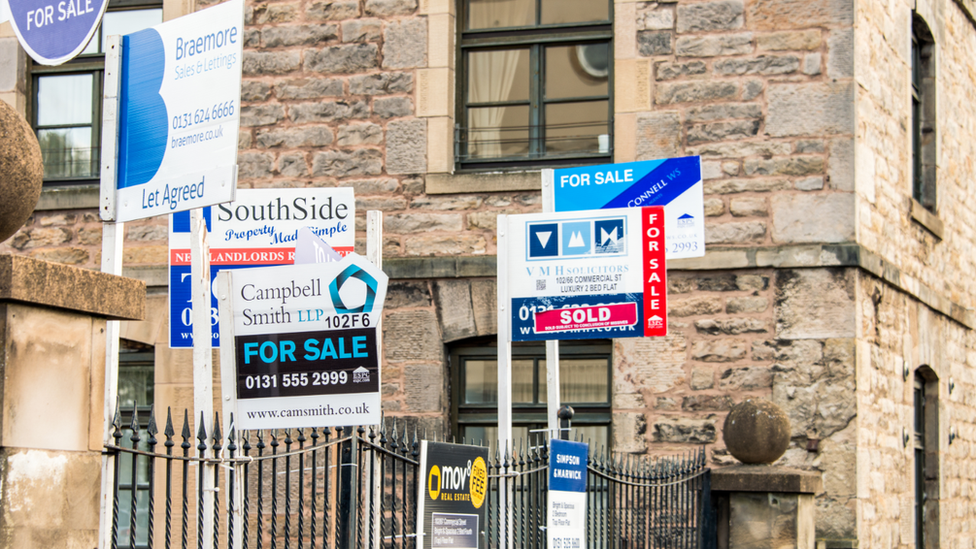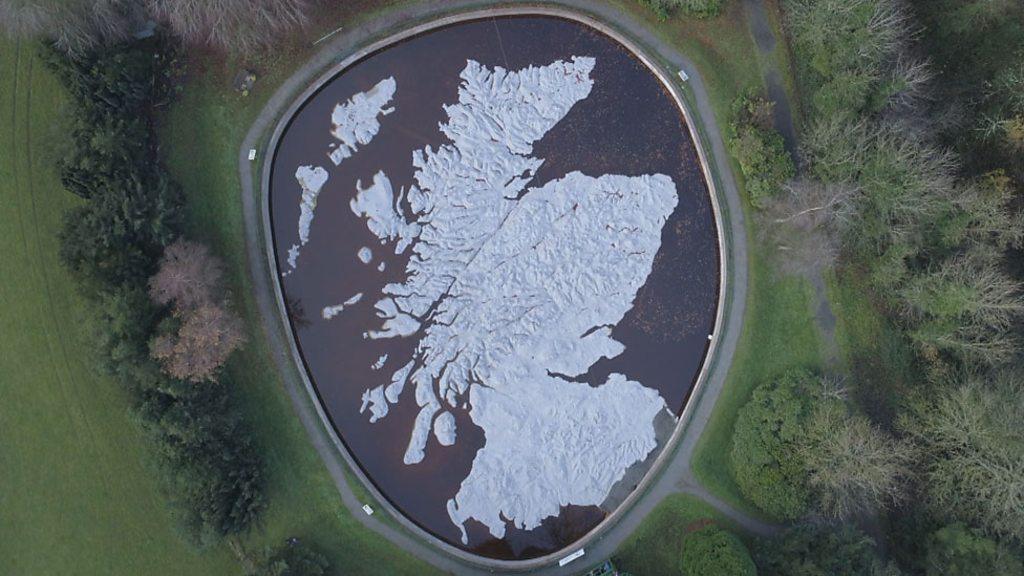Scotland At Home: Hunkered down
- Published

Scotland's homes market has not seen anything like the highs and lows of the English one, and prices are far below those of London.
The decade since the property boom turned to crash has seen relatively steady average prices, but a big fall in the number of transactions.
BBC Scotland News is starting a series of reports which will look at the market, the role of house builders and of private landlords, and the quality of design.
A roof over your head probably and rightly ranks among your top priorities. Securing it in the right place, at an affordable price, and with enough space are high priorities for all of us.
And if you're a resident of Scotland, facing temperatures down to minus 10 degrees in the next day or so, it matters that your home has a sound roof, and the rest of it is reasonably well insulated.
Homes and housing can help to define a nation, through communitarian shared space or individual asset ownership. They can symbolise what is wrong with a city, as was long the case with Glasgow.
They carry the culture of communities; through shared tenement stairs and back greens; rural clusters of cottages, some dependent on a laird; behind security gates and at the end of long driveways: or suffering loneliness behind the door of an ill-designed city block.

BBC Scotland's business and economy editor Douglas Fraser is looking at the state of the housing market on radio, TV and online
What are Scotland's vital housing statistics? BBC Scotland's Douglas Fraser finds out.
Our housing is shaped by choices we make, but also very strongly by public policy and choices made in passing legislation. MSPs choose the standards of insulation for new buildings, and determine the planning laws.
Yet in a series of reports on which I've been working for some months, I've been struck by how much the the private sector determines the shape, location, the quality and price of our homes.
I've been asking whether that relationship is right in Scotland - between public and private, between house builder and home buyer. Should it be re-balanced? Do we get the homes we need? And the homes we desire?
Do house builders put up the homes they know they can sell - which is almost any home - with an explicit commitment to shareholders that they maximise profit in doing so? Or does profit maximising for a few very large companies happen to coincide with the best outcome for home owners?
First, for TV, radio and here online, I've sought to track where we've been in the past 10 or so years, for which new-builds are only a small part of the big picture. The start of last decade saw runaway house price inflation, fuelled by reckless lending.
That story is branded on our memories. The banks got a lot of the blame, but home buyers were eager to join in the party and the spoils of home valuations that rose faster than people earned money.
The banks were told to rein in their lending. Regulators want them to hold bigger balances to protect against another downturn in the market, and to ask for bigger deposits. The rules for ensuring mortgage applicants could afford to pay were overhauled.
Banks and other lenders now have to take so long in assessing an applicant's finances that they are reluctant to do so until the transaction is a done deal. That has slowed up the conveyancing process and introduced more uncertainty into it until a late stage.

That might have been expected to soften prices. But 10 years ago, politicians and regulators were faced with a difficult choice - to let the market fall, and to allow it to adjust with many repossessions by lenders, or to prop up the market as a vital part of the confidence that the British economy desperately needed.
They chose the latter. Banks were told to go easy on those failing to make mortgage payments. Interest rates were taken down to record low levels. They have barely begun to recover. And while much of southern England suffered the roller-coaster of boom turning to bust, Scottish prices remained calm. Average prices didn't move much.
Last year saw a slight uptick in the value of completed transactions. Some areas have fared much better than others - as is always the case. But house price inflation in Scotland has been very subdued. Valuations have been eroded. Equity in one's home has not been the leverage with which to borrow that it was before the crash. There has been no dramatic change, and no panic.
Putting some numbers to that, the average price of a home transaction in 2007 had risen steeply to £155,000. It stayed close to that until 2014, when it rose to around £166,000. In 2017-18, it rose to £175,000 - a rise of 13% in a decade - and the most recent figure, for the end of 2018, was £182,000.*
For rent
For first-time buyers, most of them young, there has not been the rebalancing that the market required to help them get on that first rung - needing a bigger deposit, tighter controls on affordability, burdened also by student loans, with pay stuck in the doldrums, and for many, career progression likewise becalmed.
That generation of millennials has become Generation Rent. The size of the private rental market has nearly doubled, to around 15% of all homes. Rents have gone up in many places and cases. And the state of repair of private rental homes has become a major concern of policy-makers.
Twenty years ago and more, their primary concern was in the damp, crowded squalor of too much council housing and the social rented sector. With billions spent on that, and billions of debt written off, that sector has been transformed.
Property churn
What did fall in the private property market, and sharply, has been the number of transactions - down by more than half with the crash, and recovering only slightly. At its peak, more than 150,000 transactions took place in 2007-08. Three years later, only 70,500 did so. Last year, the number scraped over the 100,000 mark.
It is the churn of properties that makes money for estate agency and legal conveyancing. The value of the market went from £23bn at peak to less than £11bn at its trough, only two years later. Last year, it was just below £18bn. Inevitably, there have been harsh job consequences in the property sector, though in small numbers, they have rarely made headlines.

That sales rate remains the key problem for the sector. Not enough homes are coming to market. People are wary of buying before they sell. And they are wary of selling, if they can't see a big choice, and a clear path to their next home. We've found a tendency for people to stay put, where they are, and to meet their need for extra space by building an extension.
Reform of stamp duty, now devolved to Holyrood and known as Land and Buildings Transaction Tax (LBTT), has skewed the tax burden towards buyers of more expensive properties. It's explicitly progressive.
For anything you pay over £325,000 - and that included around 8% of transactions last year - you pay 10% of that tranche, and 12% for amounts over £750,000. Those 8% of transactions represent 55% of tax take from LBTT.
Property professionals say that, too, has put a chill on the upper end of the market, which has knock-on effects further down.

One consequence is that Edinburgh home-buyers contribute a very high share of the total. Part of the story of Scotland At Home in the 21st century is the growth of the Edinburgh economy and its sprawl into neighbouring council areas, including the Lothians, Fife and Forth Valley. As one example, the finance was signed off last week on a rapid expansion of the village of Winchburgh, near Linlithgow, which will have nearly 3,500 new homes.
The story of the London property market, which wildly skews any averaging of the UK market, has an echo in the Scottish capital when compared with the rest of the country.
The slow pace of sales is now meeting Brexit uncertainty. House builders warn that investment is being frozen not only by industry but also by prospective home-buyers.
The prices aren't moving much, but property experts last month responded to the regular questions from the Royal Institution of Chartered Surveyors with the message that the sales outlook is the worst for 20 years, including the great credit crunch crash.

In brief, a note about these house price averages: for simplicity, we've used a simple average of transactions filed with the Registers of Scotland. But there is an alternative number, the House Price Index, external, or HPI, compiled with the Office for National Statistics and comparable with the rest of the UK.
It irons out the statistical quirks that grow out of averages, and of disproportionate shares of the type or value band of homes being bought and sold.
The HPI suggests the average value of a Scottish home is much lower than the average value of transactions. In November 2018, it was put at £151,000.
In Wales, the HPI put the average at £161,000, in Northern Ireland, it was £135,000 in November, after a much bigger bust and recovery than other parts of the UK over the past ten years.
In England, the comparable HPI figure was £247,000. Much of that is explained by the London effect, at an eye-watering £473,000 per home.
- Published23 January 2019

- Published22 January 2019
